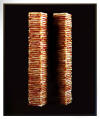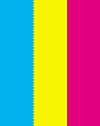Inkjet Papers
http://www.inkjetart.com/index.html
Bond Paper

Cheap papers are
suitable for normal printing for pictures to share with friends and family, and
also have their use for proofing pictures you intend to print for sale or
display on more expensive materials.
Opacity
How
see-through is the paper? The higher the opacity, the less that printed text and
images will bleed through to the other side. This is especially important for
double-sided printing. Inkjet photo papers have a relatively high opacity (94-97
usually) compared to ordinary inkjet or laser papers so bleed-through is less of
a problem with these papers.
Brightness
The brightness of a paper is normally determined by how rough the
surface of the paper is. A course or rough paper will scatter light in several
directions, whereas a smooth paper will reflect more of the light back in the
same direction. This makes the paper appear brighter, which in turn makes any
image on the paper appear brighter. You can see this yourself by comparing a
photo in a newspaper with a photo in a magazine. The smooth paper of the
magazine page reflects light back to your eye much better than the rough texture
of the newspaper. Any paper that is listed as being bright is generally a
smoother-than-normal paper.
Weight
Paper weight may be
expressed in pounds (lb.) or as grams per square meter (g/m2). Different types
of paper have their own weight scale. The bond papers which include most inkjet
photo papers are found in the 24 to 71 lb. (90 to 270 g/m2) range.
or
500 sheets of bond paper with a size of 17" by 22"
have a weight of 20 pounds.
The manufacturer would cut a sheet that big into
four letter-size sheets, so a 500-sheet ream of 20-pound bond paper weighs 5
pounds.


UNTITLED, 2003
Block of fir, ream of paper 2 x 8.5 x 11 inches



TWO TOWERS, 2003
Chromogenic print of artist-made construction from McDonald's French fries and
Heinz ketchup, photographed by Richard Nichol 50 x 40 inches Edition of 10
Caliper
Photo
papers are heavier and thicker than typical multi-purpose papers. This
thickness, known as caliper, is necessary to accommodate the greater ink
coverage typically found in photos. Typical inkjet paper caliper may be anywhere
from a thin 4.3 mil to a thick 10.4 mil paper. Photo paper is usually 7 to 10
mils.
Another key factor in image quality is absorption. When the ink is
sprayed onto the paper, it should stay in a tight, symmetrical dot. The ink
should not be absorbed too much into the paper. If that happens, the dot will
begin to feather. This means that it will spread out in an irregular
fashion to cover a slightly larger area than the printer expects it to. The
result is an page that looks somewhat fuzzy, particularly at the edges of
objects and text.

Imagine that the dot on the left is on coated paper and the
dot on the right is on low-grade copier paper. Notice how irregular and larger
the right dot is compared to the left one.
As stated, feathering is caused by the paper absorbing the ink. To combat
this, high-quality inkjet paper is coated with a waxy film that keeps the
ink on the surface of the paper. Coated paper normally yields a dramatically
better print than other paper. The low absorption of coated paper is key to the
high resolution capabilities of many of today's inkjet printers. For example, a
typical Epson inkjet printer can print at a resolution of up to 720x720 dpi on
standard paper. With coated paper, the resolution increases to 1440x720 dpi. The
reason is that the printer can actually shift the paper slightly and add a
second row of dots for every normal row, knowing that the image will not feather
and cause the dots to blur together.
Gloss Finish
The
coating on photo papers give your printed photos the look and feel of
photographic prints. Because the coating keeps the paper from readily absorbing
the ink some glossy papers dry slowly. However, quick-dry gloss finishes are
common today. The finish may be described as high gloss, gloss, soft gloss, or
semi-gloss, each reflecting the amount of shine. Satin is a less shiny coated
finish.
Gloss
papers are generally made for non-archival use. They range from highly
reflective plastic films to materials with a relatively low gloss, that are
almost closer to a pearl or luster finish.
Pigment
printers seldom produce good results on gloss surfaces, often giving very slow
drying and patchy results.
Matte Finish
Images
printed on photo matte papers appear soft and non-reflective, not shiny. Matte
finish papers are not the same as regular inkjet finish papers. Matte finish
photo papers are thicker and are specially formulated for photos. Many matte
finish papers are printable on both sides.
Matte
papers are suitable for both pigment and dye based inks. For those printing in
black and white in particular, matte surfaces give less brilliant prints than
glossy, with lower maximum densities. However, visually the lack of surface
reflections can make the blacks look good, and once framed under glass, the
differences between prints on glossy and matte are quite hard to distinguish.
Matte
papers differ greatly in their surface texture and color, from optically
brightened intense cool whites through warm whites to those that might be called
cream or even pale yellow. Some papers are extremely flat, while others have
quite intrusive textures that can overwhelm detail in images and are only
suitable for large prints depending on broad effects.
Fine
Art Papers
- Archival
qualities
Three factors -
paper, ink and paper coating - interact to determine print lifetimes, as well as
the environmental factors including storage and display conditions. Good papers
are likely to lead to longer lifetimes, and as with most other media, this
generally means acid-free materials.
The best papers
are generally made from 100% cotton rag rather than wood pulp, and these tend to
be expensive - at least a dollar for an A4 sheet and often rather more.
The fine art papers
share two main qualities - they are expensive and have a matte surface.
Although nominally all
white, some might more accurately be called pale yellow. All are acid-free, most
are 100% cotton.
Coated or Non-Coated?
You will need a coated
paper to get good prints with either dye or pigment inks.
Optical Brighteners
Some fine-art papers
contain optical brightening additives (OBAs.) Their use is controversial as they
are known to yellow with age, but they give the paper a higher brightness.
If you have a UV
light source, you can use it to detect the presence of OBAs, as they glow under
UV.
Because of their
coatings, most of these papers will print well using the 'photo inkjet paper'
settings on your printer, or possibly the 'glossy film'. For most inkjet papers
you need to alter a paper feed setting, often a lever at the right of Epson
printers to the + setting. The thickest 310gsm or higher weights may be
difficult to feed even then; use a backing sheet and aid the feeding by hand
before sending the data to the printer.
Dust Removal
With all fine art
papers - but especially with the Hahnemuhle range - ensure that the surface is
clean and dust-free immediately before printing by brushing gently with a soft
2" brush kept for this purpose, then using a blast of air. As well as removing
anything loose on the paper surface that will drop off after printing to leave a
white spot in the print, this also helps to prevent a build up of fine dust that
can clog printer heads and mechanism.
Handling
All printing paper
needs careful handling, and fine art materials even more so. Avoid touching in
the printing surface, and load ways load the paper before you print, rather than
relying on auto loading.
Since all fine art
papers have a non-glossy surface, there are seldom if ever any problems with the
'pizza wheel' effect where the paper feed wheels on some printers can make marks
on prints.
Sample packs
Many companies that sell inkjet paper
provide sample packs containing a few sheets of the different papers they stock
at reasonable prices, and it is worth getting these to decide which paper you
prefer to use.
Hahnemuhle Papers
Hahnemuhle, a German company in the paper business for some 400 years, makes
some of the most widely used fine-art coated papers for inkjet printing. Many of
their papers are re-sold by other companies in different packaging, but it is
often cheaper to buy them under the original name.
http://www.hahnemuhle.com/icm11be.nsf/(html)/FramesetFineArt
German Etching
German Etching is a great paper, a slightly warm white with just enough texture
to be interesting without getting in the way of the print. German Etching looks
and feels good, with deep blacks and saturated colors, especially with pigment
inks. Although an acid-free archival paper, it is not 100% cotton rag and may
include OBAs.
Photo Rag
Photo
Rag is, as the name suggests, a 100% rag paper, and is a neutral bright white
smooth paper designed to last several centuries. It is available in both 178 gsm
and 308 gsm weights. The coating seems very similar to that on the German
Etching, and it seems to suffer slightly less from the occasional surface
flaking I've noticed with this paper. Photo Rag is also made in a version coated
on both sides for double-sided printing.
Photo
Rag is an attractive paper with a fairly smooth surface and a bright clean white
color. Unfortunately, like German Etching it may contain OBAs. The lighter
weight material is still a tough and easy to handle paper, and better if you
want to mount work, as the thicker version is pretty substantial. Some printers
may have problems feeding this or the other materials over 300 gsm.
Photo Matte and Gloss
Their
'Photo Matte' is a 100% alpha cellulose (Sulphite Paper), a relatively
cheap paper with a smooth matte bright white surface, and is more a typical
light weight (170 gsm) matte paper than a fine art paper; they also make a 'Photo
Gloss' that gives a fairly similar appearance to a typical RC gloss paper.
These latter two papers are also sold by Lysonic, and by Lumijet as 'Gallery
Gloss' and 'Soft Suede'. Several other ranges of 'Photo Gloss' and 'Photo Matte'
are also likely to be these materials.
Arches Infinity
Papers
http://www.archesinfinity.com/flash_index.htm
http://www.dpandi.com/newsreviews/reviews/ai/index.html

Paper
has been made on the Moselle River in the Vosges region of Arches, France since
1748. Their latest product is a state of the art fine-art digital paper, which
promises to be a fine product. It is OBA free 100% cotton mould-made paper, with
a coating on top of either the hot-press (smooth) or cold-press (textured)
Arches paper that has been a favourite of leading artists for many years.
Designed (and priced) for museum-quality prints, the paper is available in 230
gsm and 355 gsm, with the lighter weight being suitable for most desktop
inkjets.
Print this sheet until
solid blocks are produced. Note that even when the white lines clear some
interference patterns may still be detectable. That will be a limitation of your
printer, not necessarily a fault. Stop the printout as soon as you are satisfied
with the output to avoid wasting ink.









